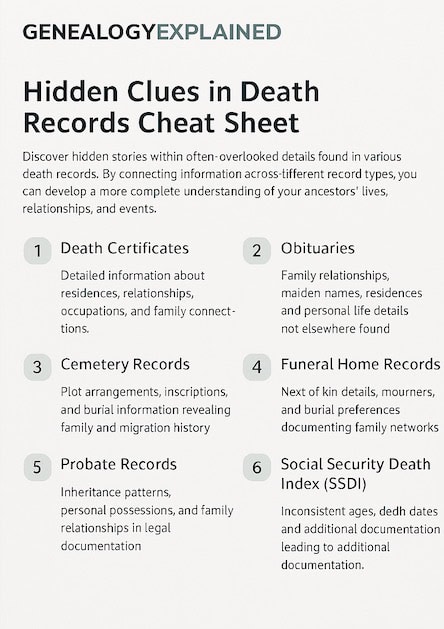Finding your ancestor’s burial location is not always easy. A death certificate may be elusive, an obituary doesn’t seem to exist, or there are several people with the same name as your ancestor buried in the town cemetery.
The best way to tackle a graveyard mystery is to follow a logical process: know what records to look for, analyze the evidence to confirm the correct identity, and contact or visit the cemetery to find the information you need.
This article will help you avoid any “grave” errors and successfully locate your ancestor’s final resting place.
Know what records to look for
The first step in locating your ancestor’s burial place is to know which records can reveal this information.
Along with a burial place, look in these records for other valuable information that can confirm the ancestor’s identity, such as dates and places of birth, marriage and death, and names of family members that could potentially be buried alongside your ancestor.
Uncover what others miss with our Hidden Clues in Death Records Cheat Sheet—a 6-page digital guide packed with pro-level strategies to decode death certificates, obituaries, cemetery records, and more!

Death certificate
A death certificate should be the first item on the checklist, as this vital record is a valuable source of information.
Death certificates will include identifying information provided by the person reporting the death, usually a family member. Although the information is only as reliable as the informant, it can still provide strong clues to point you towards other records that can confirm the ancestor’s identity.
Information provided on a death certificate usually includes: the deceased’s date of birth, parents’ names, place of birth, age at death, place of death, undertaker and/or funeral home, name of cemetery, and the informant’s name.
To locate a death certificate, you will need to know where your ancestor died. Death certificates are usually maintained by the county, but can sometimes be obtained through the state archives or state health department.
Check online databases such as Family Search to see if any death certificates have been digitized or microfilmed for the state and/or county of interest. If not, is there perhaps a death certificate index available to search?
If an ancestor is found in a death index, then a request can be sent to the state or county to obtain a copy of the actual certificate. More information about requesting copies of records is provided later in this article.
Obituaries
Obituaries can be a rich source of information about your ancestor’s life and accomplishments- or they can simply be a short announcement of your ancestor’s passing.
Either way, obituaries usually state when your ancestor died, when and where services will be held, and the location of burial. If a researcher is lucky enough to find a detailed obituary notice, it can help confirm additional identifying information such as when and where the deceased was born, names of living and deceased family members, and their occupation and hobbies.
Find out what newspapers existed for the time and place where your ancestor lived. To locate an obituary, it is necessary to have an approximate timeframe of when your ancestor died, so you will need to try and locate a date through other records.
Keep in mind that obituaries may have been published a few days to a few weeks after a person’s death. Some pre-20th century newspapers also printed year-end listings of local births, deaths and marriages, so this is another option to look for.
Online cemetery/gravesite databases
Websites like Find A Grave and Billion Graves contain millions of memorial pages for deceased ancestors. Often, these databases can be key in determining which cemetery your ancestor was buried in.
It’s important to keep in mind that the information on these sites is unverified data provided by the users, and any information found should always be corroborated with other sources. Sometimes the user who created the memorial will include a photograph of the tombstone or cemetery, or information from the deceased’s obituary, which can be very helpful.
Social Security Death Index
The Social Security Death Index contains millions of records for now-deceased U.S. citizens that applied for Social Security.
An entry is created in the index when family members file for death benefits. The Social Security Death Index can provide helpful information regarding your ancestor’s date of death, along with family member names, date of birth, and last known residence. You can learn more and search the record set in online genealogy databases such as Ancestry.
Family records
Keepsakes from family funerals can include prayer cards handed out at the funeral, clipped obituaries, and bible records listing birth, marriage, and death information. If you have contact information for any descendants of the ancestor of interest, they may have valuable information to share.
Church records
If you have evidence of your ancestor’s religious affiliation, be sure to check church records for funeral and burial information. If you are not sure where your ancestor worshipped, take a look at historical maps of your ancestor’s town to determine which churches, synagogues, etc. existed in the area, and if any still exist today. Records may have already been digitized and published on line. If not, a local parish or diocese may have archives that can be researched upon request.
Cemetery research
Cemetery research often goes hand in hand with church records. If you can determine your ancestor’s religious affiliation and what church they attended- for example, Catholic – you can then narrow your search to Catholic cemeteries in the area. Do some historical research on local cemeteries: when did they start accepting burials? When did they stop accepting burials or close down? Who is responsible for the cemetery’s upkeep today?
Don’t forget to research non-denominational and municipal-owned cemeteries. If your ancestor may have died with little money or property, check with cemeteries managed by the local city or township, who often cared for burials of the “indigent” homeless and poor.
Funeral records
Conduct some local history research to determine which funeral homes existed at the time your ancestor died. If the funeral home still exists, they may have helpful records regarding your ancestor’s services. If they no longer exist, another local funeral home may have taken over. Funeral homes don’t always archive their records for long periods of time, but it can be worth it to call and inquire.
Local historical and genealogical societies
If information cannot be found online, be sure to reach out to the local historical or genealogical society. These groups will very often keep indexed cemetery records, obituaries, and church records for their area. Often they will provide lookup services, perhaps for a small fee. Society volunteers are often the best people to contact to get valuable information on your ancestor’s burial place, so be sure not to overlook this offline resource.
Analyze the evidence to confirm the ancestor’s identity and date of death
Analyzing the evidence is a critical step to ensure you have found burial information for the correct ancestor- especially if that ancestor had a common name. You may discover that there were several “John Smiths” buried in the same cemetery as your John Smith! Compare the personal details provided in the record types listed above, along with information found in other common genealogical sources such as birth certificates and census records, to ensure consistency. Creating a table or chart to compare data such as birth dates, ages and names of family members can help reveal anything amiss.
Remember that information provided in records for your ancestor’s family members can also be valuable. For example, husbands and wives were usually buried together, so locating the spouse’s burial information can often lead you to the ancestor you seek. Children that died young and children that did not marry are often buried in a family cemetery plot, so this may provide additional clues.
Confirming the WHO is the first step that must be completed before determining the WHERE and WHEN of an ancestor’s burial.
Tips for requesting information
Before reaching out to a county clerk, archive, or local cemetery, you must know who to contact, what information is needed, and what fees are required for research requests. Often this info can be obtained online, or by calling the office for information. When sending a request via email or “snail mail,” keep it simple, just the facts- the clerk’s office does not need to hear the whole story about how you discovered poor old Great-Aunt Margaret was buried in the township cemetery. Be sure to include a check or money order for the required fees, including any printing or copy fees. Generally, genealogists do not need “certified copies” of death certificates- check if the clerk’s office can provide a “genealogical-use” copy at a reduced cost. Also remember to include a postage-paid return envelope if requested.
When contacting a local cemetery or sexton’s office, you will need to provide as much information as you can. If the exact date of death is not known, the office may need to do additional research to locate your ancestor. Once located, the cemetery can likely provide or directions to where your ancestor’s plot is located, and perhaps other information regarding their burial. Be aware that some less fortunate ancestors may have been buried in a “potter’s field” or mass gravesite, and will therefore not have a headstone or exact location of burial.
It’s also a great idea to ask the cemetery who owned the plot, and who else is buried there. Often times there are more people buried in the plot than indicated with grave markers.
Visiting your ancestor’s gravesite in person
So you have finally discovered where your ancestor is buried and are ready to visit the cemetery! Be sure to keep the following information in mind.
Call ahead and ask for office hours so that you can obtain assistance from someone at the cemetery office. If the cemetery is quite large, you will need help locating your ancestor’s grave. Additionally, if the cemetery is privately owned or is not usually open to the public, you must get permission to visit. The office can also provide driving directions if the cemetery is in a rural area or difficult to see from the main road.
Sometimes smaller cemeteries may not have an office on-site and records may be handled at a nearby office or funeral home. If this is the case, you must be sure to call ahead to know where to go to obtain the needed assistance.
Be safe and travel with a friend- whether in a city or rural area, it is always safest to travel with a friend when visiting a cemetery. Your partner can help you navigate and take photos as well.
Don’t cause any damage. Gently wipe stones or cut away weeds or grass to get a clear picture. If the gravestone is older it may be falling over, cracked, broken, or the inscription may be worn and difficult to read. If this is the case, it is not a good idea to try and fix the stone or attempt to take a gravestone rubbing, as this can cause further damage.
If you are interested in helping to restore gravestones in your ancestor’s cemetery, reach out to the cemetery, or local historical or genealogical society, to find out more information on cemetery restoration projects.
Make notes and take pictures- who else is buried in your ancestor’s plot? Who is buried nearby? Make sure to look at the front and back of your ancestor’s tombstone so that no important information etched into the stone is missed.
By following the steps above, you will be well on your way to “unearthing” where your ancestors are buried!



What about cremation? I know laws are changing in respect to where you can scatter ashes. Other than an obituary, how would you find out if a person was cremated?
Great question! If there’s no obituary mentioning cremation, you might try funeral home records or cemetery offices, as they often handle cremation arrangements. Death certificates can also sometimes note cremation. I’ll look into this topic more and might share tips in a future post!
I had gone through every piece of information to find the burial place of a client’s great grandmother. I finally found a small note in the newspaper of her funeral. The funeral home was listed and when I contacted them I found their records went back to the early 1900s. She died in Stockton California. That’s when I realized she had likely died in the California State mental hospital. A trip to the Archives in Sacramento gave me the sad answer and the history leading up to her death. As to where she was buried there was no trace of it although it was very likely she was cremated. I was at least able to give her great-granddaughter some peace.
Always check every place the ancestor lived, not just the place of death, for an obituary. I found a much better obituary for my 2ggm in Ripley, Ohio, where she grew up, than in the Illinois city where she died.
When citing a death certificate as a source, I always include the informant’s name and their relationship to the deceased. (If known)
Is it possible that if a person died around 1909, that their family might have just dug a hole and buried them with no notification to the local officials
Anything is possible I suppose.